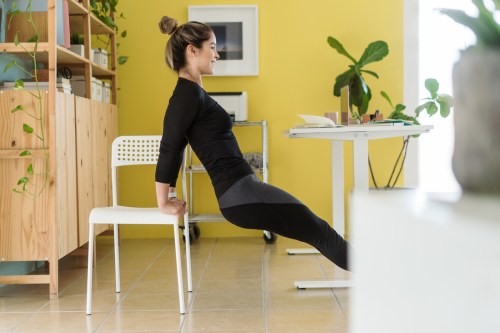Between everything we’re supposed to juggle daily—work, cleaning, self-care, the list goes on—sometimes trying to squeeze in a workout can seem impossible. But all the talk of microdosing in recent years got us thinking: Can the concept be applied to fitness, too?
Experts in This Article
professor of exercise and sport science at Western Colorado University
performance coach at Future
Traditionally, the term “microdosing” relates to taking small doses of psychedelics to help “manage pain, trauma, depression, or one’s overall sense of wellbeing,” Well+Good previously reported. Now, the concept of microdosing (i.e. incorporating small doses of anything, really) can be applied to many parts of our lives—from your skin-care routines to, you guessed it, your fitness routines.
“Similar to the concept of using medicine in small doses, fitness microdosing is the practice of integrating brief, targeted movement breaks or ‘microdoses’ throughout the day,” says Lauren Powell, PhDc, CSCS, a performance coach at Future. “The primary goal of fitness microdosing is to optimize workout efficiency and maintain consistency without compromising your fitness goals or your schedule.”
According to Powell, fitness microdosing is becoming increasingly popular because it’s an accessible way for busy, everyday people to stay active. “While many of us have busy schedules, it’s unrealistic to claim that you don’t have even five minutes to spare for movement,” she says. Think about it: A 20-minute walk over your lunch break, squats and lunges while watching Netflix, and a 10-minute mid-afternoon yoga flow add up.
Lance Dalleck, PhD, professor of exercise and sport science at Western Colorado University, also says that fitness microsing can be more enjoyable relative to longer workouts. “This can contribute to better exercise adherence over the long term,” he says.
But is fitness microdosing as beneficial to your health as working out in the traditional sense?
Of course, the primary benefit of exercising in small portions throughout the day is that it’s more manageable for many individuals. But that’s only the beginning of the perks.
“Accumulating exercise in small bursts—i.e. 10 minutes of moderate-intensity exercise—throughout the day can elicit important health benefits, such as improved cardiorespiratory fitness and lower blood pressure,” says Dr. Dalleck. “The fact that short bursts of exercise provide meaningful health benefits is great news for those people with chaotic schedules.”
Furthermore, according to Dr. Dalleck, there are comparable benefits from both intermittent exercise (or short bursts) and continuous exercise.
“As an example, we’ve done a fair amount of research showing a single 10-minute bout of exercise that includes two 20-second sprints can provide the same benefits as traditional, moderate-intensity exercise performed for 30 minutes,” he says.
Something else to keep in mind is how fitness microdosing could play a role in combating sedentary behaviors. After a morning workout, for example, it may be common to find yourself mostly sitting for the rest of the day. Because you’ve already checked that item off your to-do list, you may not feel the need to do anything more than you already have which means you’re missing out on non-exercise activity thermogenesis, something that is as important, if not more so, than working out when it comes to matters like longevity, for example.
Given that prolonged periods of sitting have been shown to increase the risk for cardiovascular disease1, dementia2, and other health issues, finding ways to stay more active is crucial. If fitness microdosing allows you to sit less and move more, that could be a major win.
How to start fitness microdosing
Getting started on your fitness microdosing journey is easy. However, here’s the catch: To ensure you’re reaching your daily exercise goals (the Centers for Disease Control recommend that adults get at least 150 minutes of moderate-intensity exercise, 75 minutes of vigorous exercise, or a combo of both per week), Powell says it’s important to at least have a general idea of when you can work these mini workouts into your schedule. This ensures that the day doesn’t fly by without enough physical activity.
“I encourage people to identify parts of their schedule where they may already have some down time, and swap out what may be sitting or standing around to some sort of intentional movement,” she says. “This can be done at any time of the day, and just about anywhere.”
These short bursts of movement can involve anything that gets your heart pumping—there’s no need to overcomplicate it. “Fitness microdosing activities can include a brisk walk around the neighborhood, stretch breaks, short cardio bursts, or even household chores,” says Powell. She recommends having multiple ideas for movement at your disposal. That way, when you find yourself with a short window of time, you’ll know exactly how to fill it.
How about if you work in an office with limited options? Or maybe you don’t have time to change out of your work clothes into activewear. In this case, Dr. Dalleck recommends finding exercises that can be performed in normal clothing that you can do without access to traditional workout equipment. For instance, body-weight movements and exercises that make use of nearby stairs.
However you choose to get in your exercise throughout the day, Powell suggests keeping track of what you’re doing somewhere, like in your Notes app or fitness tracker. “This will help you continue to grow and improve,” she says. “For example, set a timer for two minutes to knock out as many push-ups as you can. Today you may get 10, but that gives you a goal to beat for next time; this allows for continued progress and motivation.”
Fitness microdosing (aka exercise snacking) may not be for everyone. But if being able to skip a traditional workout for shorter bursts of movement is more fun, enjoyable, and manageable to your lifestyle, it could make staying active a seamless part of your daily routine.
Sign Up for Our Daily Newsletter
Get all the latest in wellness, trends, food, fitness, beauty, and more delivered right to your inbox.
Got it, you've been added to our email list.











